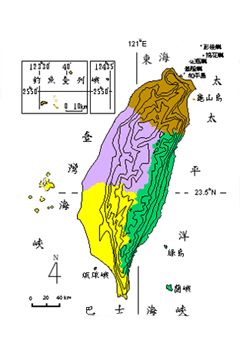The Hydrology of Taiwan

Relevant Websites
- Water Resources Agency Ministry of Economic Affairs
- Da-he-lian
- Zi-ran-he-chuan
- Shui-zi-yuan-guan-li-yan-jiu-shi
- Shui-zi-yuan-yan-jiu-zhong-xin
- Coastal Ocean Monitoring Center National Cheng Kung University
- Guo-tu-zi-xun-xi-tong-zi-ran-huan-jing-ji-ben-zi-liao-ku-fen-zu-
gong-xian-wang-zhan - Tai-wan-shui-tu-bao-chi-quan-qiu-zi-xun-wan
- Tai-wan-de-shui-zi-yuan
- Shui-zi-yuan-bao-yu-ji-fang-zai-yan-jiu-zhong-xin
- Water Resources Management and Policy Research Center TKU
- Office of Wetlands , Oceans and Watersheds(EPA)
- Water Science for School(USGS)
Reference
- Environmental Protection Administration Government of R.O.C., 1990: Shui-zhi-bao-hu-ji-shui-zi-yuan-zhi-yong-xu-li-yong.
- Wong, Julian C. Y., 1984: Tai-wan-sheng-zhu-liu-yu-te-zhang-ji-qi-xiang-quan-xing-de-di-xing-xue-yan-jiu, Wen-da-di-yan-suo-yan-jiu-bao-gao, Vol. 4, p.3.
- Yang, Wan-chuan, 1981: Tai-wan-zhu-yao-he-chuan-zhi-zi-yuan-tan-tao, Di-li-xue-yan-jiu-bao-gao, Vol. 5, pp. 82-100.
- Yang, Wan-chuan, 1982: Shui-wen-xue, Taipei, Department of Geography - National Taiwan Normal University.
- Yang, Wan-chuan, 1983: Di-xia-shui-kai-fa-dui-huan-jing-de-chong-ji, Di-li-xue-yan-jiu-bao-gao, Vol. 9, pp. 73-118.
- Yang, Wan-chuan, 1987: Tai-wan-di-qu-de-di-xia-shui-hau-fen, Shi-da-di-li-yan-jiu, Vol. 11, pp. 41-68.
- Yang, Wan-chuan, 2000: Tai-wan-shui-wen-lun-wen-ji, Taipei, Department of Geography - National Taiwan Normal University.
- Water Resources Agency Taiwan Province 1984: Ping-dong-xian-lin-bian-jia-tong-fang-liao-di-ceng-xia-xing-jian-ce-ji-hua-bao-gao-jing-ji-bu-shui-zi-hui, Zhong-hua-min-guo-tai-wan-shui-wen-gai-kuang, p. 25.
- Water Resources Council Ministry of Economic Affairs, 1989: Tai-wan-di-qu-de-di-xia-shui-zi-yun-li-yong-yu-bao-yu, p. 22.
A. Rivers
There are 129 rivers in Taiwan, most of which flow toward the east or west. Because the major watershed, Snow Mountain Range (Hsue-shan Shan-mo), the Central Range, has an eastward inclination, the drainage area of western Taiwan is larger than that in the east. Taiwan's rivers have the following characteristics:
a. They are fast-flowing due to their short length and steep grade. Even Taiwan's longest river, the Choshui River, is only 186 kilometers long but its degree of steepness of slope is 1/55.
b. They have a limited water flow in dry seasons, and they even became wildbachs unsuitable for sailing.
c. Their peak flow is enormous; a catchment area of 2,000-3,000 km2 often receives peak flows of up to 10,000 m3 a second.
d. They contain a high quantity of sand. That's how the Choshui River (meaning "muddy river") got its name.
e. There are active river-based rejuvenation landscapes--river terraces, valleys- within-valleys, incised meanders and alluvial fans.
B. Water resources
Taiwan's average precipitation is 900 ×108 m3 per year. After evapotranspiration and evaporation, the island has a maximum of about 637×108 m3 of surface and groundwater available. But 67~73% of the runoff is often lost, so in recent years only 166~191 ×108 m3 of water is used annually. 80~82% of the water is used for irrigation, 8~10% for daily life and industry. On average, a person uses 1,000m3 of water a year: 60% of this comes from rivers, 20% from reservoirs and 20% from groundwater.
The top three rivers in terms of runoff are: the Kaoping River (76 ×108 m3 ), Tanshui River (58×108 m3 ) and Choshui River (52 ×108 m3 ). All of them are located in western Taiwan.
There are many ponds in Taiwan's northwestern plateaus that can be considered small lakes. They are built to store up rain for irrigation. Among the natural and artificial lakes, Sun Moon Lake, Chengching Lake and Lungluan Lake now have become major tourist attractions. Thus they are valuable economically but in terms of water storage they are less important than reservoirs.
There are around 50 reservoirs in Taiwan. They are able to accomodate 30 ×108 m3 of water every year. Those having an effective capacity of over 108 m3 are the Tsengwen, Feitsui, Shihmen, Techi, Nanhua, Sun Moon Lake, Wushe, Wushe and Liuy Tan.
Taiwan's groundwater basins or other areas rich in groundwater are: the alluvial fan plain of the Choshui River, the Pingtung plain, Ilan plain, Taipei basin and Huatung longitudinal valley. Regions that lack groundwater are: Chianan plain and the northwestern plateaus. Hsinmiao and Taichung are mixed areas. Some mountains and hills whose geology dates back to the Tertiary Period or earlier do not have good percolation and end up with little groundwater.